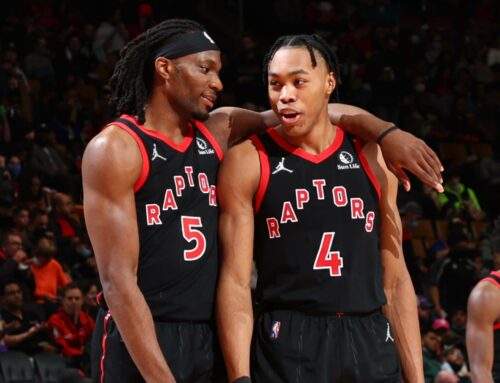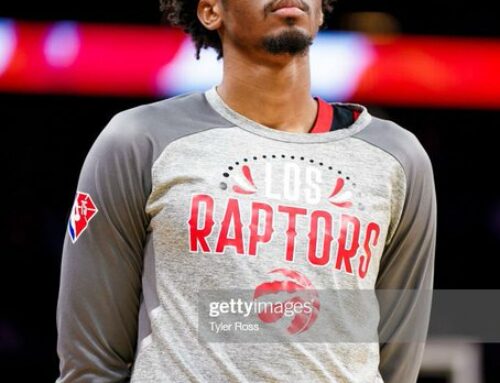It’s not often that a team’s trajectory changes so drastically late in the season.
Yet, for the Toronto Raptors in the span of three days in early April, that’s exactly what happened.
First, on April 8th, they took a flyer signing the six-foot-nine, 245-pound, G-Leaguer and walking house appliance, Freddy Gillespie, to a ten-day contract.
Then on April 11th, the Toronto Raptors and back-up centre – and Montrealer – Khem Birch, found love at first sight after the Orlando Magic bought him out.
You may first ask: who? And then query: who cares? And then follow that up with: big deal.
Not a worry. I’d find little offence to your initial confusion and apathy.
But if you are, or have observed, a Toronto Raptors fan this year, you’ll know how much this means to them.
It’s been an emotional year.
The litany of losing streaks, injuries, told-ya-so’s, aborted and completed trades, health scares, Tasmanian Devil-style-Stanley-Johnson-takes, #FadeforCade debates, and ocean-sized margins of victories and losses have fast-forwarded my already fateful balding journey several months ahead of schedule.
At the core of much of that angst has been the Raptors’ miserable centre situation.
Aron Baynes and Chris Boucher were supposed to do the trick.
The Raptors purposely piecemealed a workable frontcourt this season so as to keep the Maple Leafs Sports Entertainment vaults of gold brimming should Giannis Antetokounmpo develop an affinity for the Danforth.
That meant letting Marc Gasol and Serge Ibaka go and doing some thrifting in the offseason.
The original plan was a sneaky one. Signing Aron Baynes, on the cheap, would mitigate the loss of an ageing Marc Gasol. He wasn’t any younger – as was soon very evident – but Baynes had come off a career shooting year in Phoenix and seemed to be the kind of burly, spot-up shooting big that could fit the Raptors’ diverse systems of play.
Chris Boucher was part deux of Masai Ujiri and Bobby Webster’s sly retooling. Freshly re-signed, he would succeed Serge Ibaka’s role as the small-ball pick and pop, shot blocker. He’d split duties at power forward and as a small-ball centre – as Serge once did so effectively.
That was it. That was the plan. I was down. I think most fans were down for it too.
Those two, alongside a flourishing young cast of athletic, defensively-minded dudes, left us all hopeful.
Then the season started…badly.
Whenever some obnoxious know-it-all starts yammering on about how centres are overrated and all you need is shooting, just tell them to go watch a half-dozen Raptors games this season.
Over the course of the first three months, the Raptors were last in rebounding, defensive rebounding, opponent offensive rebounding percentage, opponent free throw attempts rate, and nearly last in points allowed and scored in the paint.
Masai’s gamble had failed before it ever really began. Antetokounmpo re-signed at the end of the off-season and Baynes and Boucher were immediately and obviously outmatched.
There’s no need to obliterate Baynes. He’s made a damn good career for himself. But unless he’s suffering from a chronic injury or residual effects from COVID-19, he’s dusted.
He had no defence to contribute: immobile on screen and rolls, porous in the lane, and useless in the post – when monsters like Joel Embiid or Rudy Gobert came to town, Head Coach, Nick Nurse, opted for forwards OG Anunoby, Pascal Siakam, and Stanley Johnson as a counter – not the six-foot-ten centre.
When given the ball on the other end of the court, Baynes appeared not to recall the orange, spherical object’s purpose. I once described his layups like he was throwing his chamberpot contents out the window. It’s often more of a huck like tossing firewood into a pile than shooting a ball into a cylinder. From three, he’s shot 25% on two attempts (8th percentile for bigs). At the rim, ninth percentile.
The Boucher experiment at centre tested well in small doses. Any prolonged experience, though, resulted in his slender frame relenting to the exhausting attrition of big violent bodies down low.
Come the trade deadline there was feverish talk over Thaddeus Young and Richaun Holmes.
Zilch.
Hence, why, after nearly two weeks of moderate success, the acquisition of a bench player and G-Leaguer is so important.
It’s a little bit difficult discerning, from a statistical perspective, their impact. Gillespie and Birch arrived as Toronto started to get healthier. Nonetheless, the two additions have restocked the Raptors’ bare refrigeroster with some thick slabs of man-beef.
They’re both a large six-foot-nine, but in different ways: Freddy G heavier and wider with a concrete block frame; Khem more athletic and agile with long loping legs. Both are extremely long: Freddy has a seven-foot-six wingspan; Khem’s just a paltry seven feet.
They’re not traditional centres. Their height foils that reality. But they fulfil core functions that were either completely lacking or supported by OG Anunoby, Pascal Siakam, and Chris Boucher collectively at an unsustainable rate.
At the defensive end, the two fit squarely into the Raptors scrambling schema: aggressively blasting screens or comfortably switching them, racing out to challenge shooters, and hunting down blocks and sucking up boards (they both improve the team’s total rebounding by 6% when they’re on the floor).
In the paint, slashers no longer have free movement that the stiff Baynes or wire-thin Boucher allowed; instead, they’re met by unforgiving walls of mass and challenged by menacingly slapping arms. The Raptors give up seven fewer points with Birch on the court; four less with Gillespie.
Watch Freddy G. He’s twice the man at full extension. Derrick White, DeMar DeRozan, and almost Drew Eubanks all found that out the hard way. On that point, having an NBA rookie – on a ten-dayer no less – fearlessly risk posterization is the grit and confidence Raptors player development seek. It’s also one thing to willingly accept the challenge, and, another to read a breakdown, recover, prowl laterally across the court, and time a block, as he does on Patty Mills. Woo boy those arms are immense.
Birch, too, is capable of staying with guards and covering ground sharply. Few centres can do that. Khem bites on DDR – everyone bites on DDR – but you see how his lateral quickness and length keeps DeRozan at bay. That switchability is exactly how the Raptors want to combat perimeter-perils.
He also is unabashed of meeting dudes at the rim.
Together, Birch and Freddy G’s vertical and lateral athleticism transform Toronto into a singular orbiting unit as opposed to Marc Gasol (a bit) and Aron Baynes (a lot) where the others were more like four streamers flying around a flagpole.
Birch is the more dynamic offensively of the two. Nurse and Co. have been quick to unlock the offensive straight jacket Steve Clifford and the Orlando Magic had strapped to Birch.
I suspect Nurse’s experience with Birch on Team Canada has given him the confidence in letting Birch experiment with other parts of his game. In Orlando, for example, he was 7/48 from three in one hundred games. Since coming to Toronto, he’s 3/6 in just six games. He’s also taken a couple of mid-to-long range jumpers. It’s not the smoothest of releases; there’s a lot of work to be done; but as is Nurse’s Modus Operandi, skill development and confidence development go hand-in-hand.
This is about making Birch feel comfortable, that he belongs, and that he has, and can meet, his offensive potential.
Already, Birch has unlocked the Raptors screen and roll – previously gummed up by Baynes – and all the actions working off of it. He’s, especially, been a catalyst to Malachi Flynn’s breakout.
You see what I mean by Birch’s leg length, he gets from top of the key to the rim in two giant-steps-for-humankind. He’s comfortable with the floater too and can finish with both hands. There are moments where he comes in too hot or chooses the wrong angle and reveals his lack of touch. They’re promising prospects all the same. Besides, this is simply stuff the Raptors did not have three weeks ago.
Birch also passes. Not the last-minute-emergency-parachute kind of a pass, but the ones that flow naturally out of reading a defence. It’s not polished or all that creative, but he knows how to get the ball out of his hands before it’s too late. Watch him find Flynn twice in big-time bombs against the Oklahoma City Thunder.
Gillespie is less versatile and capable than Birch, but he finishes confidently around the rim and sees and follows plays with the right timing – waiting patiently in the dunker spot or rolling and finding space in screen and rolls.
When he is given time to operate, his power-dribble-shoulder-to-chest reveals the paint like it’s the wardrobe to Narnia. He’s hard to block: he rips dunks when he sniffs the rim and has a soft shot naturally shielded by his frame. He also patiently pivots to find space and keeps aspirational shot blockers at bay reaching away from them or smoking them with siege ramming shoulders. No defensive rebound is a certainty for opposing teams either.
Freddy G has a lot to work on. He’s limited to short-range – he’s only taken two shots outside of that. He’s no spot-up shooter and his release is slow as maple syrup. But it’s a solid form, judging by his free throws. That’s something positive to work on in the offseason.
He’s also short and not a fast-twitch jumper – see aforementioned footwork and limbs-for-weaponry.
Freddy G and Khem both enable double big lineups with Boucher. All Baynes and Boucher lineups were in the 12th percentile on defensive points per possession. Freddy G and Boucher are in the 79th percentile; Birch and Boucher 91st percentile. They’re small sample sizes, and the Raps have played lesser opponents thus far. But that crevasse of a difference brings major optimism.
Boucher and Baynes were surprisingly quite successful offensively – likely against second units. That success has not fallen off with Birch, it has with Gillespie.
Freddy G is much more dependent and limited on how and where he finds his shot. Boucher needs a lot of space to operate and, often, relies on others too. That can perhaps be rectified with different guard rotations. They’ve only played significant time together with Flynn, Gary Trent Jr. and Yuta Watanabe – all three of whom are developing as playmakers – alongside them.
Birch and Freddy G are not necessarily long-term answers. The current success could die out. This could all be a futile exercise of small sample sizes and selective/recency bias.
Whatever.
It’s about time the Raptors found cohesion. Baynes was the weakest link, goodbye. Having no centre prevented the Raptors from ever truly accentuating, with any consistency, the advantages of their roster. They were forced to overcompensate offensively and defensively for their deficiencies in the middle. So many potentially good possessions failing to manifest or dying time and again at the rolling-pin hands of Baynes.
Fans’ souls can rest easy, for now. Emotional outbursts limited to failed reads and missed shots on the court. No more existential despair looming like a Lebron James-alien-mothership over future prospects. A healthy Raptors roster with a dependable centre rotation – I assume Baynes no longer sees action barring health issues – means true potential.
Nurse has spent the majority of the year scraping together centre-substitutes. Multiple failed experiments left on the floor of negative box-score endeavours. Now, with a potential bench core in Gillespie (he just signed a second 10-day contract), Boucher/Birch/GTJ, Watanabe, and Flynn, the Raptors have a legitimate nine to roll with.
It’s not too little too late. It’s late, for sure. But they’re within striking distance of the Play-In. When healthy, they’ve beaten the best teams in the East. There’s no reason, with these new centre pieces, that the Raptors can’t make a respectable Playoff run.





